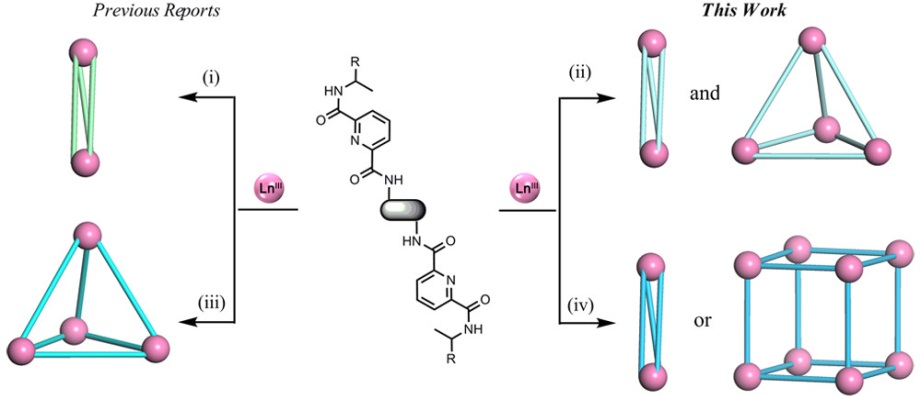
Functional lanthanide complexes have a wealth of stimulating applications in luminescent probes, magnetic resonance imaging (MRI), magnetic refrigeration and catalysis etc. However, controlled self-assembly of well-defined supramolecular lanthanide edifices is rather challenging due to the complicated and much labile coordination numbers/geometries of lanthanide ions.
A research team led by Prof. SUN Qingfu from Fujian Institute of Research on the Structure of Matter (FJIRSM) of Chinese Academy of Sciences (CAS) reported a systematical structural evolution of chiral multi-nuclear functional lanthanide architectures Ln2nL3n (n = 1, 2, 4), among which the Ln8L12 cubes exhibit excellent turn-off sensing ability in explosives detection. This study was published in J. Am. Chem. Soc.
In this study, controlled self-assembly of a group of Ln2nL3n (n = 1, 2, 4) compounds was implemented through systematic variation of the offset distances between the two chelating arms of the C2-symmetric bis(tridentate) ligands. A structural evolution ranging from Ln2L3 helicates, Ln4L6 tetrahedra to Ln8L12 cubes appeared with the increase of the offset distances.
Eutectic crystal structure containing both helicate and tetrahedral complexes from the same ligand was found for the first time in lanthanide coordination architectures, revealing the borderline case in the structural evolution process. Multinuclear Ln8L12 cubes were obtained with larger offset distances of the anthracene bridged C2-symmetric bis(tridentate) ligands.
Concentration-dependent self-assembly behavior was found during the assembly process of both Ln4L6 and Ln8L12, i.e. larger concentration of the reactants is in favor of the formation of larger-component complexes.
All the self-assembly complexes in this study exhibited characteristic luminescent properties of lanthanide-containing molecules. Moreover, the Ln8L12 cubic cages displayed high selectivity and sensitivity toward picric acid, which can serve as excellent luminescent sensor in explosives detection at ppb level. The luminescent quenching was proceeded in both static and dynamic mechanisms, with the former acting as dominant factor.
This study provides new strategies for the design and synthesis of functional lanthanide-containing molecular materials.
This team has reported stereo-selective self-assembly of chiral luminescent europium coordination tetrahedral cages with high fidelity homochiral self-sorting behavior in J. Am. Chem. Soc. and a concentration-dependent tetrahedral cage with high efficient luminescence sensing properties towards nitroaromatic compounds in Chemical Communications.
This work was supported by the Strategic Priority Research Program of the Chinese Academy of Sciences, the National Natural Science Foundation of China, and Natural Science Foundation of Fujian Province.

Figure: Structural evolution of chiral lanthanide supramolecular Ln2nL3n complexes (Image by Prof. SUN’s Group)

86-10-68597521 (day)
86-10-68597289 (night)

52 Sanlihe Rd., Xicheng District,
Beijing, China (100864)

